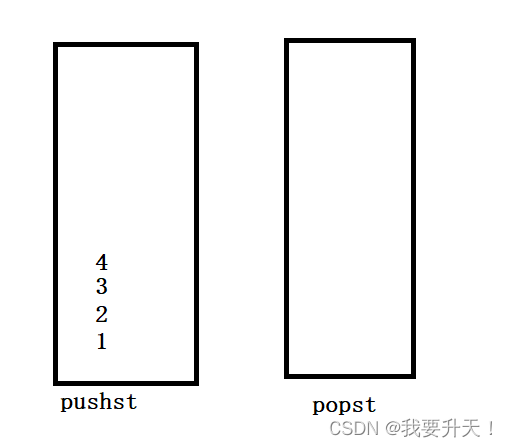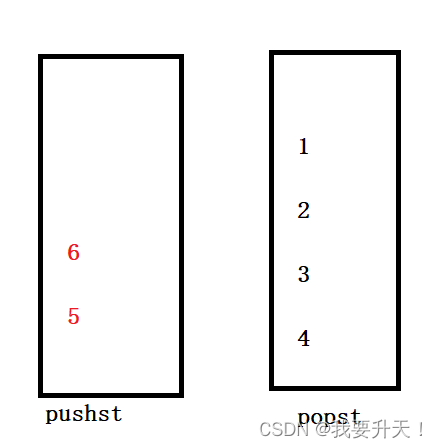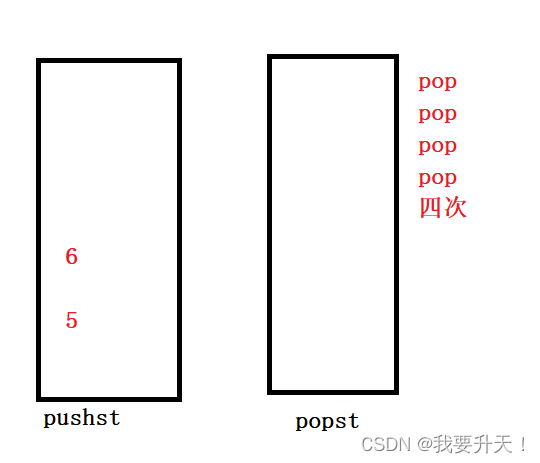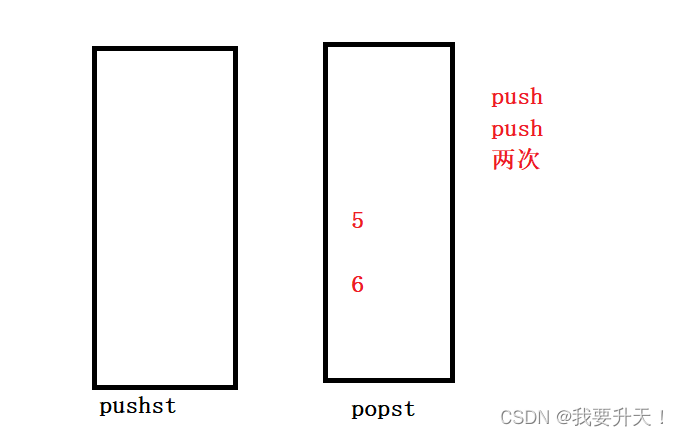目錄
- 題目
- 題目分析
- 代碼
- 棧的實現
- 結構體。
- 棧的初始化
- 棧的銷毀
- 入棧
- 刪除
- 查找頂部數據
- 判空
- 答案
- 結構體
- 初始化
- 插入數據
- 刪除數據
- 獲取隊列開頭元素
- 判空
- 銷毀棧
題目
題目分析
鏈接: 題目
請你僅使用兩個棧實現先入先出隊列。隊列應當支持一般隊列支持的所有操作(push、pop、peek、empty):
實現 MyQueue 類:
void push(int x) 將元素 x 推到隊列的末尾
int pop() 從隊列的開頭移除并返回元素
int peek() 返回隊列開頭的元素
boolean empty() 如果隊列為空,返回 true ;否則,返回 false
根據題目,我們可以知道,我們需要用兩個棧來實現隊列,棧的出入規則是后進先出,而隊列的出入規則是先進先出。
如果我們現在又兩個棧,pushpst和popst,先在pushst中入4個數據(4,3,2,1)。

如果我們要出數據的話,我們根據隊列的出入原則,應該出數據1,所以我們可以把pushst里面的數據全部倒入到popst中,那么popst中的數據為(1,2,3,4).
如圖:

如果需要出數據的話,直接按照順序出就可以了。
那么,問題來了,我們要入數據,需要在哪個棧里面入?
答案是pushst.如果我們要入數據(5,6).

pushst拿來入數據,popst拿來出數據,剛好可以滿足隊列的需求。先出四個數據。

想再出數據時,已經沒有數據了,我們需要從pushst里再次倒入數據(5,6),

再依此類推…
代碼
棧的實現
我們實現棧使用的是數組。
結構體。
先創建一個結構體
typedef int STDataType;
typedef struct stack
{STDataType* a;int top;//棧當前大小int capacity;//棧的大小
}ST;
棧的初始化
void STInit(ST* pst)
{assert(pst);pst->a = NULL;pst->capacity = 0;pst->top = 0;
}
棧的銷毀
void STDestory(ST* pst)
{assert(pst);free(pst->a);pst->a = NULL;pst->capacity = pst->top = 0;
}
入棧
void Push(ST* pst, STDataType x)
{assert(pst);if (pst->top == pst->capacity)//如果棧的空間不夠了,我們需要擴容。{int newnode = pst->capacity == 0 ? 4 : pst->capacity * 2;STDataType* tmp = (STDataType*)realloc(pst->a, sizeof(STDataType) * newnode);if (tmp == NULL) {perror("realloc:fail");}pst->a = tmp;pst->capacity = newnode;}pst->a[pst->top++] = x;
}
刪除
void Pop(ST* pst)
{assert(pst);assert(pst->top > 0);pst->top--;//只需要頂部刪除即可
}
查找頂部數據
STDataType Top(ST* pst)
{return pst->a[pst->top-1];
}
判空
bool STEmpty(ST* pst)
{assert(pst);return pst->top == 0;
}
答案
我們需要先創建兩個棧的結構體
結構體
typedef struct {ST pushst;ST popst;
} MyQueue;初始化
MyQueue* myQueueCreate() {MyQueue * obj = (MyQueue*)malloc(sizeof(MyQueue));STInit(&obj->pushst);//對每一個隊列進行初始化STInit(&obj->popst);return obj;
}
插入數據
void myQueuePush(MyQueue* obj, int x) {Push(&obj->pushst,x);//只需要往pushst里面插入就可以了
}
刪除數據
先對popst判空,如果為空,我們需要倒入數據后,再刪除數據。
int myQueuePop(MyQueue* obj) {if(STEmpty(&obj->popst)){while(!STEmpty(&obj->pushst)){Push(&obj->popst,Top(&obj->pushst));Pop(&obj->pushst);//倒入一個,記得刪除一個}}int top = Top(&obj->popst);//獲取頂部蘇數據Pop(&obj->popst);//刪除頂部數據return top;
}
獲取隊列開頭元素
跟myQueuePop(MyQueue* obj)函數類似
int myQueuePeek(MyQueue* obj) {if(STEmpty(&obj->popst)){while(!STEmpty(&obj->pushst)){Push(&obj->popst,Top(&obj->pushst));Pop(&obj->pushst);}}return Top(&obj->popst);
}
判空
兩個棧為空,隊列才為空。
bool myQueueEmpty(MyQueue* obj) {return STEmpty(&obj->popst) && STEmpty(&obj->pushst);
}
銷毀棧
先要對連個隊列進行銷毀,再對兩個棧的結構體銷毀。
void myQueueFree(MyQueue* obj) {STDestory(&obj->popst);STDestory(&obj->pushst);free(obj);
}



















